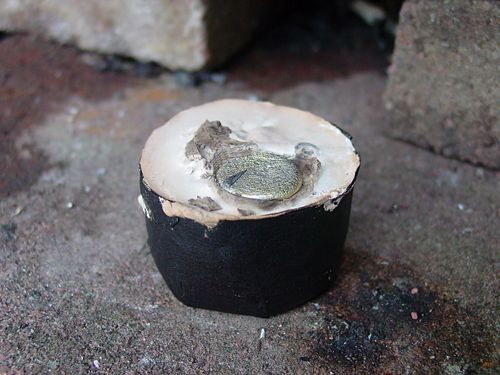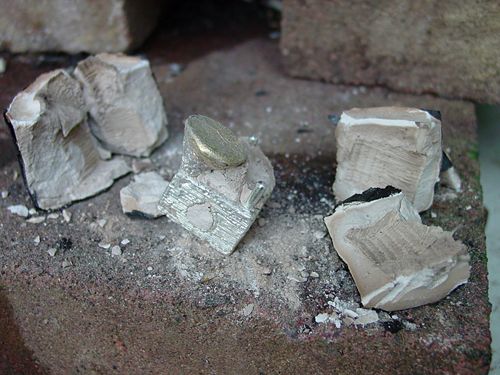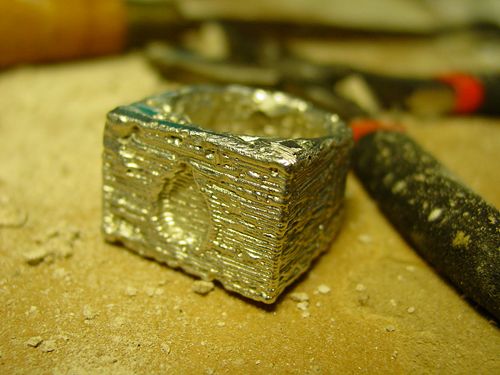Casting/Pewter
Overview
Casting is an area of great interest to RepRap, both as a direct means of self-replication, but maybe foremost an aid in the 'biological entity <-> mechanical-entity symbiosis' as well. Which RepRap is all about.
Cold Casting
(Plaster, Resin, Epoxy-Granite, etc.
Low-temperature Metal Casting
Pewter
Note: Vik's text here will need to be re-written into a tutorial sometime.
OK, so as always I cheat a bit. I used the ancient art of lost-wax casting, substituting PLA for wax. It burns/vapourises away cleanly at low temperature and is relatively benign stuff. So, how do you go about turning your PLA RepRap output into metal?
I took one standard-issue Mighty_RepRap_Power_Ring in PLA as a test subject, and stuck on a few bits of 3mm PLA where I thought it looked useful. At the highest point, I stuck a simple printed cone of PLA to act as a filling hole. Then I painted it with thinnish plaster of Paris mix. While that dried off a bit, I mixed up more plaster and snipped into it about 30cc of uncompressed household fibreglass insulation. They only need to be about 5mm long, and are mixed in to disperse as well as you can. This will help stop the mould cracking (or, more to the point, hold it together if it does).
I wrapped masking tape around the bottom of a jar (initially sticky-side out) to make a disposable paper casing for our test subject. The masking tape looks black in the photo 'cos it's well-baked. Then, a couple more spoonfuls of plaster bedded said plastered bundle into place in this little paper pot. The pot was dried overnight in a desiccator, then baked at 150°C for 15mins to drive off moisture. Next, the pot was inverted over a wire stand and foil drip-tray - out of deference for me not being in trouble for mucking up the oven. The temperature was raised to a scientific "11", and stayed that way until the conical filler hole looked absolutely clean, though slightly browned. (The PLA melts out around 180°C to 220°C).
During that time, I fired up the ol' furnace (renewable fuels, etc.) and melted a load of pewter. With the mould still really hot (and thus safely dry) I poured in the pewter and left it for a 1/2 hr or so to cool off gently. I definitely did not impatiently have-to with a can of "Freeze Spray."
With the aid of tongs, the flat side of a 160g pein hammer was strategically deployed multiple times (Adrian will remember my skill with this tool from an earlier occasion) to reveal an amazingly faithful reproduction of the ring. The pegs sticking up are where pewter got into the vent holes. You want this to happen - just trim the excess off and file down. Same goes for the filler hole, just pop the scraps back into the clearly-labelled "Scrap Pewter" box.
After a stiff brushing under hot water, I was allowed in the house - no, I mean the ring was cleaned up and presentable. An air bubble was trapped inside the ring, resulting in a blister of pewter. But pewter is soft stuff, and you can easily correct problems like that with woodworking tools and a file.
If you do all this, do take basic safety precautions. Also be wary of using metals that melt at a higher temperature like aluminium. They cause plaster of Paris to decompose in undesirable ways and you need to research it properly.
See Also
High Temperature Metal Casting (You need Investment, a special mix of plaster and non-plaster materials in order to do aluminum or bronze casting.)


